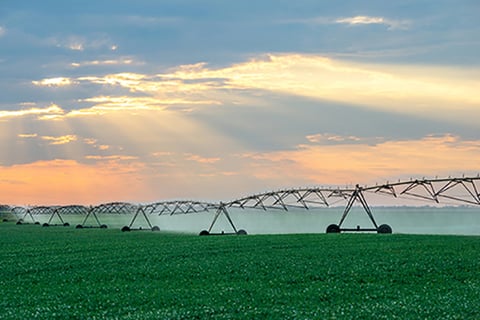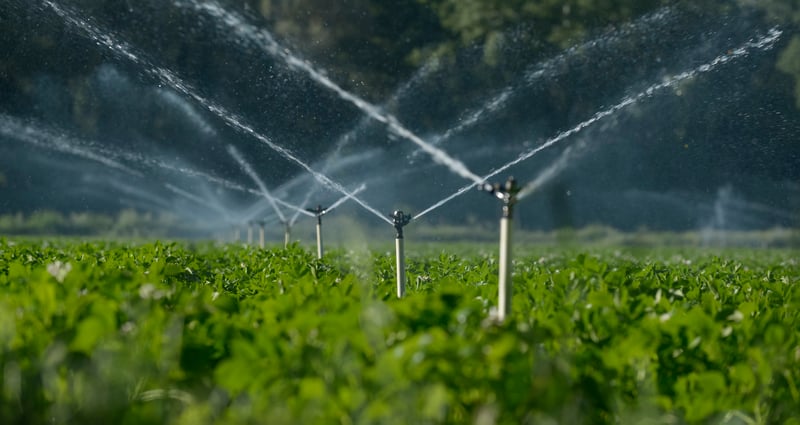
Since ancient times, civilizations have relied on the capturing of water to nourish crops. Thanks to human ingenuity, the days of hauling buckets of water from rivers to fields are long gone and have been replaced with modern technology. Let’s dive into the rich history and types of irrigation.
History of Irrigation
Early societies constructed canals, ditches, and reservoirs to divert water from rivers and streams onto fields. In Ancient Mesopotamia in 6000 BC, the flooding of the Tigris and Euphrates rivers was relied on to provide water for irrigation. Ancient Egyptians developed the basin irrigation system to utilize water from the Nile river’s yearly flood. In Ancient Rome, aqueducts were used to carry water from snowmelt in the Alps to cities and towns in the valleys below. The water was used for drinking, washing, and irrigation.
Today, modern irrigation systems use surface water from rivers, lakes, reservoirs, ponds, tanks, and wells to supply water to crops. This includes aquifers, basins that collect snowmelt, lakes, and basins created by dams. Canals and pipelines rely on gravity to carry water from the reservoir to the field. Pumps can also be used to move the water.
Types of Irrigation
When it comes to irrigating crops there are a plethora of options to choose from. The suitability of various irrigation methods depends on factors such as the soil type and slope of the land, climate, water availability, the type of crop being grown, required labor inputs, and the costs and benefits of the system. Some examples of irrigation include drip, pivot, sprinkler, and surface.

Credit: iStock, Orest Lyzhechka
Drip Irrigation
Drip irrigation is commonly used in orchards and vineyards. Water is applied directly to the soil through a network of tubes with small holes or emitters. The water is channeled from the source through water filters, a backwash controller, a pressure control valve, distribution lines, meters, electronic control block valves, tubes, fittings, accessories, and emitting devices. Filtration is an important step in the drip irrigation process to prevent equipment from clogging.
Drip irrigation is advantageous because it reduces waste from evaporation or runoff. This method provides a targeted approach to apply water exactly where it is needed. Drip irrigation is an efficient method of watering plants and reduces the amount of water required to get the job done.
Some disadvantages of drip irrigation include the challenge and expense of setup, and the system requires constant maintenance.

Credit: SteveMcsweeny
Pivot Irrigation
Pivot irrigation is a mechanized, pressurized system that can be set up in a circle or in a line. With a center pivot, water is applied in a circular pattern by pivoting around a central point in the field. While center pivots are anchored at one end, lateral systems are not, meaning both ends of the machine move at a constant speed in a straight line. This provides better coverage in a square or rectangular field. Both center pivot and lateral systems have sprinkler nozzles installed along the pipeline or hanging down from the main lateral pipe on smaller pipes or cables. The flow rates are easily adjusted with pressure regulators.
Pivot irrigation is economical for large operations and can provide good water distribution for plant uniformity. Some downfalls of pivot irrigation include the high initial investment, high energy consumption, and the entire field cannot be irrigated at once.
Credit: iStock, itsajoop
Sprinkler Irrigation
Most people are familiar with sprinkler irrigation as it is a commonly used system to water lawns. Sprinkler irrigation involves the application of water under high pressure with the help of a pump. Water is distributed through a system of pipes in a pattern similar to rainfall through small-diameter nozzles on the pipes. Operating multiple sprinklers simultaneously is the ideal setup to provide uniform irrigation.
Sprinkler irrigation systems are affordable, easy to install, and offer a large range of flow rates and wetting patterns. They are suitable for all soil types and can deliver high application rates. However, some disadvantages of sprinkler irrigation include the high pressure requirement, and the uniformity of water distribution is reduced when it is windy.

Credit: iStock, Andrii Yalanskyi
Surface Irrigation
Surface irrigation, also known as flood irrigation, delivers water to crops using gravity. There are three major types of surface irrigation: basin, border, and furrow systems.
Basin irrigation consists of level areas surrounded by embankments on all sides for water to fill the area. This form of surface irrigation is best suited for crops that can tolerate an inundation of water.
Border irrigation is similar to basin irrigation in the way they both disperse a sheet of water over a field. However, border irrigation involves a field with a slight slope and is divided into rectangular strips. The embankments do not surround the perimeter with border irrigation, allowing the water to drain off.
Furrow irrigation features channels to direct the flow of water and avoid flooding the field. Each furrow receives a flow of water from checks, pipes, or siphon tubes.
Surface irrigation involves no technology which makes it a low-cost option for irrigation. The downsides, though, are the low water use efficiency, water logging, and impaired nutrient application.
Dixon Agriculture and Irrigation Products
Dixon manufactures and supplies fittings and accessories used in a large number of applications within the agriculture industry including fluid transfer, soil preparation and sowing, irrigation, harvesting, suction and discharge, and high and low-pressure washdown.
AG-Series Agricultural Couplings

Sizes
- 1/4" to 1"
Features
- Available with poppet or ball valve
- Couplers have a PTFE anti-extrusion ring
- Poppet valve seals crimped in place to maintain integrity during excessive flow conditions and pressurized connections
- Steel componentry is plated using RoHS Compliant Trivalent Chrome
- Steel coupler sleeves are hardened to resist deformation and maximize service life
- Steel plugs are hardened to provide heavy-duty performance and resist brinelling
- Stainless steel balls, retaining rings, and springs maximize corrosion resistance and extend service life
- Push-pull sleeve option
- 1/2” body connect under pressure plug available
Materials
- Body: Steel
- Dust caps and plugs: Elastomer
150 lb. ASA Forged Flanges

Sizes
- 1" - 12"
Features
- Flush face: Lap Joint
- Raised face: Slip-On, NPT Threaded, and Weld Neck
Materials
- Carbon steel
- 316 stainless steel
Bauer Style Fittings

Sizes
- 2" to 12"
Features
- Hot-dipped, galvanized
- Has a double-pin locking lever for smooth closing action
- Type B (Bauer style) locks on the male said
- Each coupler is equipped with a safety pin to prevent accidental openings
- These fittings are not recommended for chemicals or any hazardous type materials where the possibility of leakage would result in health or environmental concerns; Consult Dixon for recommendations
Material
- Galvanized steel
Butterfly Valves

Sizes
- 2" to 8"
Features
- 10-position trigger grip handle
- Pressure rating 200 PSI at ambient temperature 70°F (21°C)
Material
- Ductile iron
Gate Valves

Sizes
- 1/4" to 4"
Features
- Female NPT threaded ends with a solid disc
- Bolted, threaded, and union bonnets depending on the material
Materials
- Bronze
- Stainless steel
- Forged steel options
Gauges

Sizes
- 1-1/2", 2", 2-1/2", 3-1/2", 4", and 4-1/2"
Features
- Standard dry and liquid-filled pressure gauges, compound pressure gauges, vacuum gauges, welding gauges, process, FlutterGuardTM, panel builder, contractor, and digital
- Lower and center back mount options
- Designed for long, reliable service under rugged conditions
Materials
- ABS
- Stainless steel
Worm Gear Clamps

Size
- Screw design: 5/16" slotted hex head
Features
- Four-piece construction
- Maximum recommended torque 50 in. lbs.
- All clamps sold 10 per box
Materials
- Band and housing: SAE 300-series stainless
- Screw: SAE 1018 case-hardened, hex-free chrome zinc-plated steel
- Screw: SAE 300-series stainless
King Combination Nipples

Sizes
- 1/2" to 12"
Feature
- Beveled end, groove end, or BSPT end
Materials
- 316 stainless steel
- Aluminum
- Brass
- Plated steel
- Unplated steel
Mill Hose

Sizes
- 1" to 6"
Features
- Coupling options: NPSH female or NST (NH) female and male King™ short shank couplings, or female and male (C & E) global aluminum cam and groove
- 25, 50, and 100' lengths
- Single or double jacket
- Consult Dixon for pricing and availability of additional lengths and other configurations
Materials
- All polyester outer construction
- Tube construction: black, PVC rubber
Polypropylene Cam & Groove

Sizes
- 3/4" to 4"
Features
- 1/2" couplers and adapters will interchange with 3/4" couplers and adapters, only the threads and barbs are 1/2"
- 1-1/4" couplers and adapters will interchange with 1-1/2" couplers and adapters, only the threads and barbs are 1-1/4"
- NOT recommended for use with PTFE gaskets, polypropylene cam & groove should not be mixed with metal fittings
Material
- Glass-filled polypropylene
Summary
The need for irrigation to produce viable crops remains just as important today as it was in ancient times. However, the methods of irrigation have changed dramatically. The advancement of technology has transformed the types of irrigation found in agriculture and requires more components to keep systems functioning properly. Dixon is delighted to provide a variety of the components needed for irrigation. Visit dixonvalve.com for more information or call 877.963.4966 for recommendations on your specific application.


